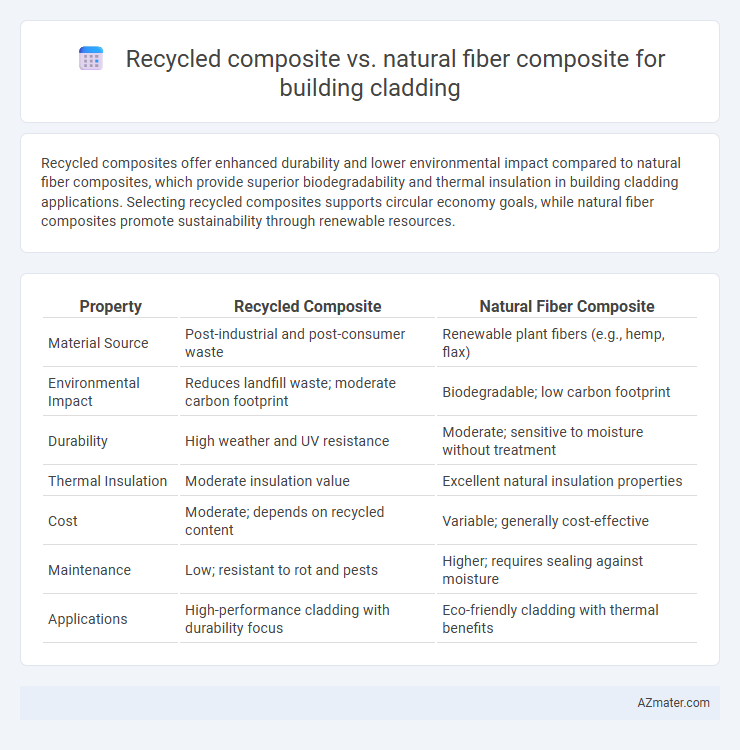Recycled composites offer enhanced durability and lower environmental impact compared to natural fiber composites, which provide superior biodegradability and thermal insulation in building cladding applications. Selecting recycled composites supports circular economy goals, while natural fiber composites promote sustainability through renewable resources.
Table of Comparison
| Property | Recycled Composite | Natural Fiber Composite |
|---|---|---|
| Material Source | Post-industrial and post-consumer waste | Renewable plant fibers (e.g., hemp, flax) |
| Environmental Impact | Reduces landfill waste; moderate carbon footprint | Biodegradable; low carbon footprint |
| Durability | High weather and UV resistance | Moderate; sensitive to moisture without treatment |
| Thermal Insulation | Moderate insulation value | Excellent natural insulation properties |
| Cost | Moderate; depends on recycled content | Variable; generally cost-effective |
| Maintenance | Low; resistant to rot and pests | Higher; requires sealing against moisture |
| Applications | High-performance cladding with durability focus | Eco-friendly cladding with thermal benefits |
Introduction to Building Cladding Materials
Building cladding materials play a vital role in protecting structures and enhancing aesthetics, with recycled composites and natural fiber composites emerging as sustainable options. Recycled composites offer high durability and weather resistance by repurposing industrial waste, reducing environmental impact. Natural fiber composites, derived from renewable sources like hemp or flax, provide lightweight, biodegradable alternatives with good thermal insulation properties suitable for eco-friendly construction.
Defining Recycled Composite Cladding
Recycled composite cladding is made from repurposed materials such as reclaimed wood fibers, plastic waste, and industrial byproducts, offering a sustainable alternative to traditional building materials. This type of cladding enhances durability, reduces environmental impact, and often features superior resistance to moisture, insects, and UV radiation compared to natural fiber composites. Its production minimizes landfill waste while maintaining structural integrity and aesthetic appeal for modern architectural applications.
Understanding Natural Fiber Composite Cladding
Natural fiber composite cladding offers enhanced sustainability by utilizing renewable fibers such as hemp, flax, and jute, combined with bio-based or synthetic resins to create lightweight yet durable panels for building exteriors. These composites provide excellent thermal insulation, moisture resistance, and aesthetic versatility, making them an eco-friendly alternative to traditional materials while reducing carbon footprints. Their biodegradability and energy-efficient production processes contribute to sustainable construction practices, aligning with green building certification standards.
Environmental Impact Comparison
Recycled composites, made from post-consumer or industrial waste such as plastic and fiberglass, significantly reduce landfill contributions and resource extraction compared to natural fiber composites derived from materials like hemp, flax, or jute. While natural fiber composites offer the advantage of biodegradability and lower embodied energy due to renewable biomass, recycled composites excel in diverting plastics from oceans and waste streams, contributing to a circular economy. Life cycle assessments reveal recycled composites generally have lower carbon footprints and environmental toxicity, although natural fibers provide benefits in carbon sequestration and end-of-life compostability for building cladding applications.
Mechanical Properties and Structural Performance
Recycled composite materials for building cladding often exhibit enhanced mechanical properties such as improved flexural strength and impact resistance compared to some natural fiber composites, making them suitable for high-stress applications. Natural fiber composites offer lightweight characteristics and good tensile properties but may suffer from lower moisture resistance and durability, potentially limiting long-term structural performance. Advances in polymer matrices and fiber treatments are bridging gaps in strength and longevity, positioning both recycled and natural fiber composites as viable, sustainable alternatives for cladding with tailored mechanical performance.
Durability and Weather Resistance
Recycled composites for building cladding often exhibit superior durability and weather resistance compared to natural fiber composites due to their enhanced resistance to moisture, UV radiation, and temperature fluctuations. Natural fiber composites tend to absorb water, leading to potential swelling, degradation, and reduced lifespan when exposed to harsh environmental conditions. Advanced recycled composites incorporate materials like reclaimed plastics and resins, providing longer-lasting performance and lower maintenance requirements in exterior applications.
Aesthetic Considerations in Cladding Design
Recycled composite cladding offers a diverse range of textures and colors that can mimic traditional materials like wood or stone, enhancing aesthetic versatility in building design. Natural fiber composites provide an organic, warm appearance with unique grain patterns, appealing to sustainable and biophilic architectural trends. Both materials support customization in surface finishes, allowing architects to balance durability with visual appeal for innovative facade solutions.
Installation and Maintenance Requirements
Recycled composite cladding offers easier installation due to its uniform material properties and pre-finished surfaces, reducing labor time and tool wear on site. Natural fiber composites require careful handling to avoid fiber degradation during installation and may need specialized fasteners compatible with moisture-sensitive components. Maintenance for recycled composites typically involves low upkeep with resistance to rot and insect damage, while natural fiber composites may require periodic sealing or treatments to preserve durability and prevent moisture-related issues.
Cost Analysis and Economic Viability
Recycled composite materials for building cladding typically offer lower initial costs compared to natural fiber composites due to the use of industrial waste and reduced raw material expenses, making them economically attractive for large-scale projects. Natural fiber composites, while often more sustainable and renewable, can incur higher production costs related to fiber treatment and variability, impacting their economic viability especially in budget-sensitive construction. Long-term cost analysis must consider durability, maintenance, and lifecycle performance, where recycled composites often provide competitive advantages through enhanced resistance to weathering and reduced replacement frequency.
Future Trends in Sustainable Cladding Materials
Recycled composites are gaining traction in building cladding due to their reduced environmental impact and durability, offering a sustainable alternative to traditional materials. Natural fiber composites, derived from materials like hemp and flax, present a renewable, lightweight, and biodegradable option that enhances energy efficiency through improved thermal insulation. Future trends indicate increased adoption of hybrid composites combining recycled and natural fibers to optimize performance, cost-effectiveness, and ecological benefits in sustainable building cladding solutions.

Infographic: Recycled composite vs Natural fiber composite for Building cladding
 azmater.com
azmater.com